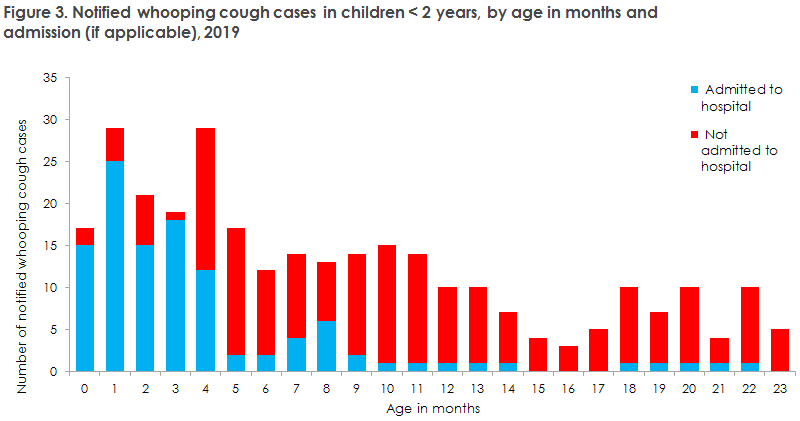No 27/33 - 2020
Laboratory-confirmed whooping cough 2019
Laboratory-confirmed whooping cough 2019
In 2019, a whooping cough epidemic affected Denmark and the epidemic continued until the spring of 2020.
A total of 3,691 cases of whooping cough were detected in 2019, compared with 1,023 and 1,064 cases in 2018 and 2017, respectively. In 2016, when another epidemic affected Denmark, a total of 2,089 cases were detected. In 2019, the occurrence was highest on Funen and in North Zealand, and lowest in North Jutland.
For a detailed epidemiological description of the 2019 occurrence, please see the 2019 annual report on laboratory-confirmed whooping cough.
The 2019 epidemic started in the early summer on Funen and then spread to all of Denmark, EPI-NEWS 38/19. From July 2019 and until February 2020, the whooping cough incidence was thus heavily increased. In March 2020, when the COVID-19 restrictions were imposed, a drastic decrease was observed in the number of diagnostic analyses for whooping cough, and thereby in the number of whooping cough cases detected. Presumably, the general measures implemented to limit community transmission have contributed to ending the whooping cough epidemic.
The highest incidence observed during the 2019-2020 epidemic was recorded in January 2020 when 874 cases were detected, Figure 1.

The age profile for whooping cough in 2019 during the epidemic was very much in line with the age profile otherwise seen, Figure 2. Thus, whooping cough was detected in all age groups, but with a higher incidence among young, unvaccinated infants and among older schoolchildren. Furthermore, an increased occurrence was seen among 35-55-year-olds, probably due to increased transmission and increased attention to the condition among parents to children with whooping cough.

(T. Dalby, Department of Bacteria, Parasites & Fungi)
Whooping cough in children below two years of age
Laboratory-confirmed cases of whooping cough in children below 2 years of age are individually notifiable on Form 1515.
2019 saw a total of 299 notified cases of children under 2 years with whooping cough.
For a detailed epidemiological description of the 2019 occurrence, please see the annual report on whooping cough in children below the age of two years .
Among the 299 notified children below 2 years of age, 116 (39%) were unvaccinated, whereas 57 (19%) had received all three primary whooping cough vaccinations. Eight of the notifications among unvaccinated children stated that the lacking childhood vaccination was due to conscious opt-out.
The share of fully vaccinated children below two years of age who have whooping cough detected is normally only 10-11%. The reason for the higher share of fully vaccinated children during the epidemic is probably the increased infection pressure, but also increased attention to the diagnosis and therefore to sampling.
A total of 37% of the children below two years with whooping cough were admitted to hospital for one or more days, Figure 3. Among infants below 5 months of age who had received a maximum of one vaccination, 74% were admitted to hospital. As shown in the figure, the young unvaccinated or partly vaccinated children are more affected by the condition and require admission to hospital.

No whooping cough-related deaths were recorded among children below 2 years of age in 2019.
Offer of whooping cough vaccination for pregnant women in their second and third trimester
From 1 November 2019 to 22 June 2020, a total of 24,279 pregnant women have accepted the offer. At 60,000 annual births, approx. 5,000 will need vaccination every month, provided the coverage is 100%. Based on this number of births, the coverage in the initial six months has been 76%, though it has followed a decreasing trend as the period has passed. Data on the effect of the vaccination to avoid whooping cough among infants below three months of age will be presented at a later date.
(L. Hallundbæk, F. Kristensen Lomholt, L. Krause Knudsen, P.H. Andersen, Department of Infectious Disease Epidemiology and Prevention)